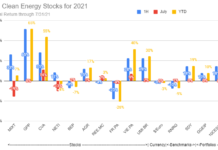Bottom line: Weak share reactions to upbeat news from Trina, ReneSola and Ming Yang reflect investor skepticism towards new energy stocks, as they face lingering issues of overcapacity and phasing out of government subsidies.
A flurry of upbeat news is in the headlines today from 3 of China’s largest new energy equipment makers, led by a return to the profit column for solar panel maker ReneSola (NYSE: SOL) after a year in the red. At the same time, wind power equipment maker Ming Yang (NYSE: MY) also announced its latest quarterly results that were quite upbeat, and solar panel maker Trina (NYSE: TSL) said it obtained a modest new financing from some major global lenders.
But contrary to expectation, investors greeted the string of upbeat news by dumping shares of all 3 companies, reflecting a high degree of skepticism in the market. Ming Yang led the downward migration, with its shares slipping 3.7 percent after it announced its latest quarterly results. Its shares now trade more than 17 percent below the price for a previously announced buyout bid to take the company private.
ReneSola shares didn’t fare much better, shedding 1.5 percent after it announced its return to the black. Trina did the best of the trio, with its shares only closing marginally lower after it announced it received $90 million in new financing in two different facilities from US banking giant Wells Fargo and Britian’s Barclays Bank.
It’s worth noting that shares of all 3 companies are all well above lows reached back in September when skepticism about the sector’s future was highest. But a looming end to state subsidies for new energy power plants in many major markets is creating worries that these manufacturers could struggle if their products can’t become more competitive with conventional energy sources.
Ming Yang highlighted that potential risk in its otherwise upbeat quarterly report, which showed that its profit jumped nearly 30 percent in the third quarter to 91.5 million yuan ($14.4 million), as revenue grew slightly to 1.7 billion yuan. (company announcement) The improved profitability came partly on rising prices, even as the company warned that China was likely to phase out wind power subsidies over the next 5 years.
ReneSola Returns to Black
Next there was ReneSola, which reported its return to the profit column in this year’s third quarter after a year of losses. Most of China’s solar panel makers sunk into the loss column during a major sector downturn 4 years ago, but the stronger ones have all managed to return to profitability and stay there over the last 2 years.
ReneSola returned to the profitable club with its announcement of an $8.6 million net profit in the third quarter, reversing a $2.3 million loss in the previous quarter. But the return to the black came as the company also posted a slight year-on-year decline in quarterly revenue, reflecting its new focuses on building power plants with less emphasis on boosting output.
Last there was Trina, which announced it has received credit facilities worth $60 million and $30 million from Wells Fargo and Barclays, respectively. (company announcement) Neither sum is particularly large, but the more important signal is that Trina could get such private sector funding at all. Until recently, many of these panel makers were forced to look to government sources for funding, and were largely shunned by commercial banks due to their shaky financial position.
All that brings us back to the original issue of the latest market sentiment towards these companies, as they search for formulas to ensure their long term survival. There’s clearly a big degree of skepticism towards the group, which is facing double challenges of overcapacity and pressure from changing government policies. Some of the stronger names like Canadian Solar (Nasdaq: CSIQ) still look like good bets over the longer term, though we probably still need to see some consolidation before the broader sector can be said to be back on solid footing.
Doug Young has lived and worked in China for 15 years, much of that as a journalist for Reuters writing about Chinese companies. He currently lives in Shanghai where he teaches financial journalism at Fudan University. He writes daily on his blog, Young´s China Business Blog, commenting on the latest developments at Chinese companies listed in the US, China and Hong Kong. He is also author of a new book about the media in China, The Party Line: How The Media Dictates Public Opinion in Modern China.








